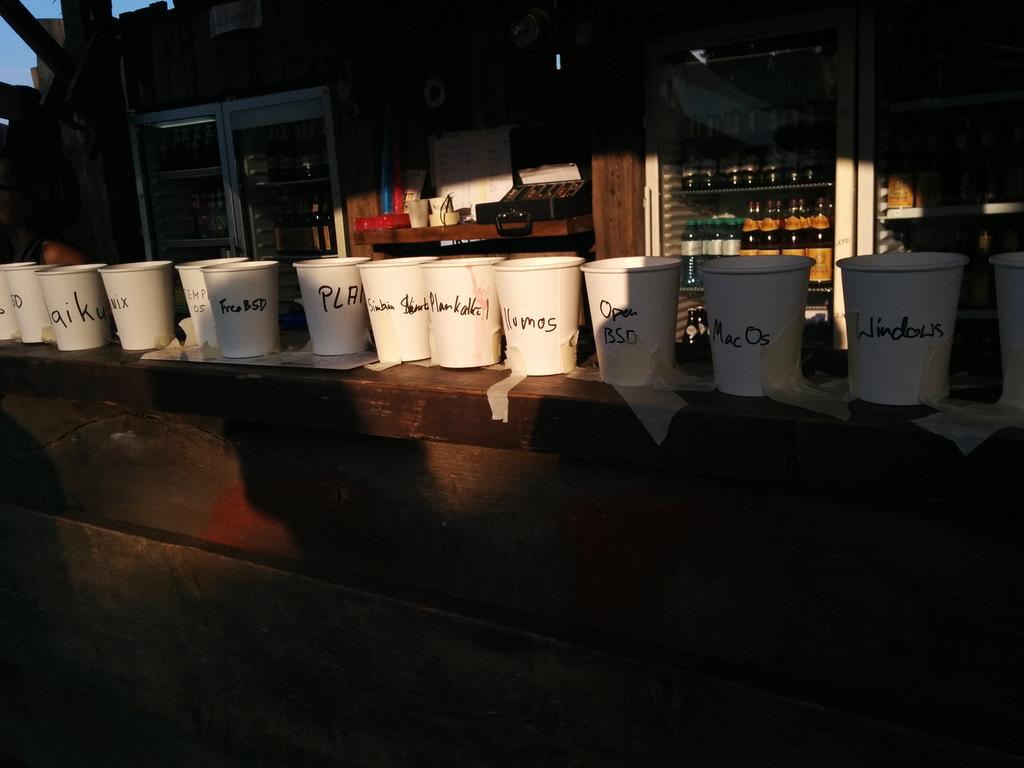Originally posted on the Aspiration blog

Chaos Communications Camp, like the World Cup, is something so special that it only happens once every four years. It’s a few thousand hackers, artists, and activists camping together in Germany. We come together to share skills, stories, and ambitions, including how to get into space and provide secure internet in austere places. There’s brightly colored hair everywhere, and a slowly improving gender ratio, and stickers on laptops, and a gig of data to your tent. There are disco balls in trees, and competing soundscapes of German techno and old rock and roll or hiphop, and a giant sparkly rocket ship called Fairy Dust. I camped with Norton’s Obscure Phoggy Embassy (the manifestation of a few Bay Area hackerspaces). Aspiration was invited to join a conversation called “What’s the Catch?” put together by Nat from Open Technology Institute with Josh (also from OTI), Kate (from Tor), and me. Our topic was an ongoing debate in information security (and other) circles: is it possible to take money from governments and corporations while maintaining a project’s integrity? Aspiration asserts that decision making power explicitly remain with the project team, that larger ideals and the ability to implement towards those ideals is a tension worth continually checking, and that it’s vital to interact with funders like the human beings they are (with whom one can have honest conversations). We also think that, while some funding has taken meaningful steps to remedy this, most organizations set up a competitive environment in which it’s difficult for fundees to collaborate and build together.
You can watch the video here, but what follows is a bit more fleshed out overview of how we think about funding, especially from governments and large corporations. A slightly more personal (and ranty!) version of this entry can be found over on my blog
A guiding principle on this convoluted issue is best expressed by a quote from the Zapatistas, one of the few groups to maintain a governance structure after their revolution: “caminando preguntamos,” which roughly translates to “we walk while asking questions.” It can mean that we should move, but analyze as we do. That we should be in both critique and solidarity with each other.
Here are some of the questions to ask when considering funding sources…
…when considering projects in general, but also the funding sources potentially associated with them:
- Does this project have a finite objective (such as legalizing gay marriage) or is it a municipality requiring ongoing upkeep (like the internet should be)? If it’s a municipality project, the harder it should be pushed for detachment from systems which inflict continual low-grade violence through things like debt or brain drain, as issues are more thoroughly embedded into long-term systems. When the goal is finite, it’s likely more comfortable to request money from organizations with overall objectionable objectives. Where things get interesting is where it’s possible to take finite steps within a municipal project.
- How can this project be co-opted? Just because the people you’re directly working with are acting in good faith and are skilled, does not mean that the larger organization of which they are a part will be trustworthy. Check your paperwork – be sure you maintain (open) intellectual property, that messaging is clear, etc. Also think about how self-actualized people might co-opt a fairly standard tool for their own purposes. We advocate strongly for trusting the frontline community, rather than seeing them as placid lambs, for instance.
- How can the adversary be engaged? In peace building, just like in hacking, the adversary shouldn’t be ignored, but should be in mind while designing the project – up to and including having them as a part of the project. If we don’t go to such drastic measures (when wise to do so), change doesn’t stick, and/or we create oscillations in the opposite direction. The Do No Harm framework is useful for this, showing how to take the Hippocratic Oath from medicine and bring it into resource deployment and project design when you have to worry about the social ramifications.
Assumptions to make:
- Technology should always be in service to nonprofits (and by proxy, their end users). Change does not happen overnight, and nonprofits are organizations which help us transition away from the political and economic models which we must nonconsensually deal with on a regular basis currently.
- No one is perfect. That doesn’t mean we’re worth giving upon. One might feel same way about many organizations, locations (including home – it’s easy to think of disaster and humanitarian issues as ones which happen far away), and even governments.
- We need a pluralistic approach. We don’t expect what we do to work for everyone, nor vica versa, but it is possible for us to learn from each other. The challenges we face are massive, and there isn’t such a thing as a silver bullet. Many things in combination are what comprise, and shift, systems.
- We need to trust people to be able to make their own decisions, rather than being paternalistic. People are not naive like we sometimes want to think they are, blind to trust in an organization because a logo appears somewhere. We are not their protectors. We are in the same mess as everyone else, doing the best we can. That is still glorious and worthwhile.
We want to challenge you to consider your projects and assumptions, and what it would take to “win.” And how do we transition to that world? We walk while asking questions.
